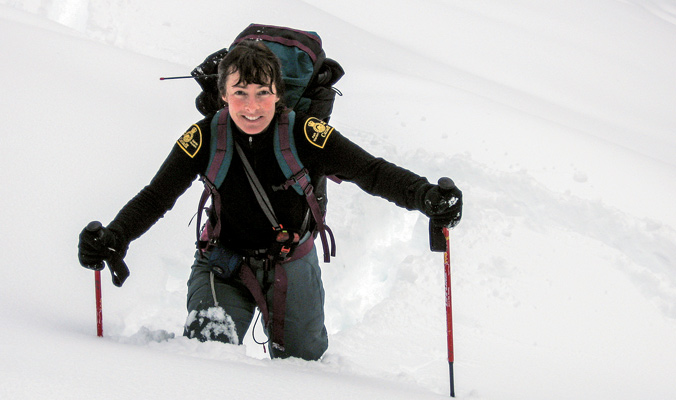
Sylvia Forest forges a path all her own. [Photo] Danyelle Magnan, Courtesy Parks Canada
Sylvia Forest grew up in the arms of mountains. When she was just three years old, the Calgary high school that her older brother and sister attended sent the pair home with a permission slip to climb mountains with the Alpine Club of Canada (ACC) and a request for a driver. Their father, Don Forest, volunteered.
“He sat by the vehicle while the kids went climbing, thinking, Well this is boring,” Sylvia recalls. “He asked to go along the next time.” That moment launched Don, then 43 years old, into a destiny as a self-taught Canadian mountaineering legend: he became the first person to climb all of the 11,000-foot peaks in the Rockies and Columbias, a feat he finished in his early 60s, and he climbed the west face of Mt. Logan at 71. He sewed that same passion and curiosity for adventure into his daughter’s story.
“My dad took it upon himself to get me out of my mom’s hair,” Sylvia says. She has a clear memory of skiing to the Wapta Icefield’s Bow Hut at 10 years old in -25°C temperatures, and, when she became exhausted from her heavy pack, her dad pulled her along.
From there, Sylvia knew she wanted to become a mountain guide—but she first gravitated to the warden’s service, thanks to another extraordinary family member.
When Sylvia was 14, her sister Kathy Calvert became the first female park warden in Canada, based in the Yoho. “She made me realize things were possible for women, that you didn’t have to take traditional roles,” Sylvia says. “Being a warden was an amazing career, doing everything from managing wildlife and vegetation, law enforcement and backcountry travel.”
It also introduced Sylvia to mountain rescue and avalanche control, two things that would define her future as she began taking courses to become a mountain guide in 1995. Diny Harrison had just become the first female Canadian internationally certified mountain guide, and Sylvia became the fifth in 2001.
With the ultimate mountain training completed, Forest relocated to Revelstoke in 2005 to work at the helm of Rogers Pass’s mountain rescue program, another area where the mountains were woven into her story. Several of her formative skiing and climbing trips unfolded among the giants west of her Calgary hometown, including an ascent of Mt. Tupper at age 13 and a mission in her 20s to ski from the Bugaboos to Rogers Pass with her sister and two other women that marked the first female traverse of the iconic route.
Rogers Pass in the mid 2000s was already one of most complicated regions in the world for public safety. But Forest was no stranger to complication, coming from Jasper with its massive rescue program.
“Rogers Pass was just a different beast with big snowfalls, big snowpack and avalanche problems,” she says. “We still trained for all kinds of rescues and medical emergencies, but avalanches became the huge component—and not just responding, but avalanche planning and public education.”
To further complicate public safety, those years saw the early signs of the coming explosion in backcountry skiers and a push for access to areas that had historically been permanent avalanche-control closures. Forest stepped up as one of the main architects of the pass’s modern permit system, which called for a gargantuan leap of faith in people to follow a set of high-stakes parameters defined by live artillery and regular avalanche events.
“We were open-minded about what was possible,” she recalls. “We did the groundwork for figuring out the permit-area boundaries using science, technology and a rational approach.” Today, thanks to Forest and her team, the pass issues upwards of 5,000 permits to backcountry skiers while maintaining safety along the highway corridor in an area that sees approximately 2,000 recorded avalanche events annually.
Forest retired from the pass in 2013, but she’s a long way from retiring from the mountains, making her home today in nearby Golden. She’s realized her dream of guiding full time, as a mountaineering guide by summer and, by winter, with Great Canadian Heli-Skiing and the ACC and through teaching professional-level avalanche courses for the Canadian Avalanche Association.
She’s not done with the pass, either. “My first trip to Rogers Pass when I was young, you could ski up any valley and not see a soul, constantly breaking your own trail because there was no one around. It’s changed so much,” she says. “But I have some objectives up there I still really want to do. I’ll be back there.”
—
The author, Cassidy Randall is a recent transplant to Revelstoke’s fairytale of B.C. powder and is regularly stunned by the access to the giant terrain of Rogers Pass that’s right off the highway.











Pleased to read this…
Great story about Sylvia.
I’m hoping for an autobiography